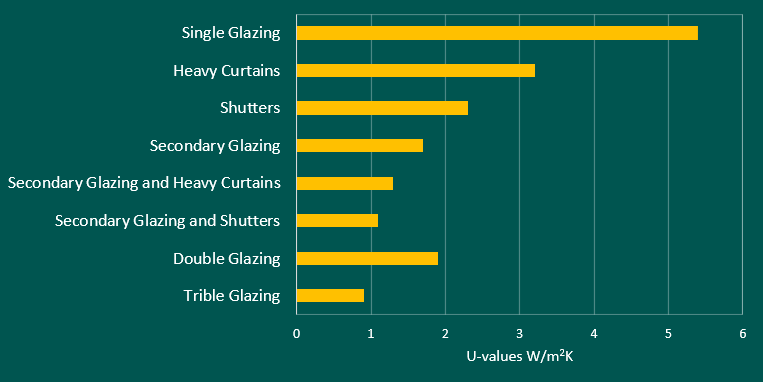Discover More
Thermal blinds and curtains
Energy Efficiency Week 2021 / Friday
Level 2: That’s it. Curtains!
Now that the dark nights are drawing in and winter is on the horizon, thermal blinds or heavily lined curtains can be a sound investment to help keep you cosy at home. They have the added benefits of sound insulation and may also help you stay cool in the summer.
 |
|
Curtains reduce the amount of air exchange between a cold window and the rest of the room. Air in a room is always trying to equalize itself. The cold air at a window mixes with the warm air in the rest of the room. If you trap the cold air behind a poor conductor (such as a curtain or blind) the rest of the room air remains warmer.
The effectiveness is largely based on how airtight the cloth is and how tightly it fits to the window on all sides – the top and floor (or windowsill) as well as the sides.
NOTE: One thing to be mindful of is if there are radiators underneath the windows. If you have full length curtains that cover a radiator, you’re not only blocking drafts, you are also preventing heat from entering the room.
Curtains with a thermal lining are a relatively cheap option, the thicker the better. If you don’t want to splash out on new curtains you can line them yourself with materials like fleece.
It’s not just windows that can have curtains. Placing a curtain on external doors adds another layer of protection.
Cellular shades, also know as honeycomb blinds, are made of two different pieces of material. The front and back sections of the cellular shade are open in the middle, which creates an insulating pocket of air.
Whether you opt for curtains, blinds or even shutters there is lots of evidence to show how good they are at keeping the heat in, the cold out and saving on energy that we would otherwise have needed to keep our homes warm.

Privacy Overview
| Cookie | Duration | Description |
|---|---|---|
| cookielawinfo-checbox-analytics | 11 months | This cookie is set by GDPR Cookie Consent plugin. The cookie is used to store the user consent for the cookies in the category "Analytics". |
| cookielawinfo-checbox-functional | 11 months | The cookie is set by GDPR cookie consent to record the user consent for the cookies in the category "Functional". |
| cookielawinfo-checbox-others | 11 months | This cookie is set by GDPR Cookie Consent plugin. The cookie is used to store the user consent for the cookies in the category "Other. |
| cookielawinfo-checkbox-necessary | 11 months | This cookie is set by GDPR Cookie Consent plugin. The cookies is used to store the user consent for the cookies in the category "Necessary". |
| cookielawinfo-checkbox-performance | 11 months | This cookie is set by GDPR Cookie Consent plugin. The cookie is used to store the user consent for the cookies in the category "Performance". |
| viewed_cookie_policy | 11 months | The cookie is set by the GDPR Cookie Consent plugin and is used to store whether or not user has consented to the use of cookies. It does not store any personal data. |



